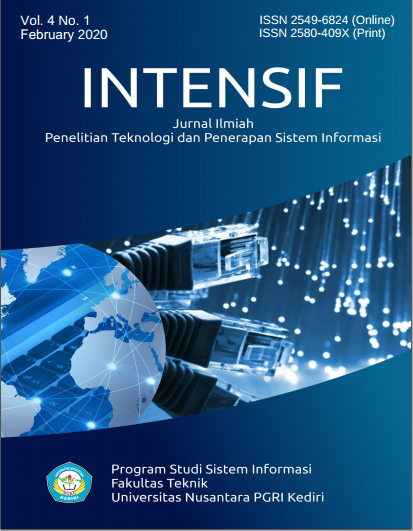Parallel Class Ranking Model Using Analytic Hierarchy Process With Multi Criteria
DOI:
https://doi.org/10.29407/intensif.v4i1.13769Keywords:
parallel ranking, analytic hierarchy process, MAN BanyuwangiAbstract
Madrasah Aliyah Negeri (MAN) Banyuwangi using a worksheet which can lead to error occurrences and slow decision making. A system for decision support that can improve the ranking process and quality were developed in this paper. The proposed system implemented the codeigniter framework, MySQL database, and PHP programming language. The system provided three user roles which are teacher, student, and administrator role. These four parameters are used as ranking system input, including academic values, non-academic values, violation scores, and student attendance. The ranking process was conducted by applying the analytic hierarchy process (AHP) method. The developed decision support system was tested using two ways: the black box testing method and providing questionnaires. Black box testing result shows that the system has functionally worked, while user’s questionnaire gives 92,29% well accepted by users. The results show that the decision support system can help manage values and determine the parallel ranking list.
Downloads
References
A. Majid, Perencanaan Pembelajaran Mengembangkan Standar Kompetensi Guru, 7th ed. Bandung: Rosda, 2011.
S. Arikunto, Dasar - Dasar Evaluasi Pendidikan, 3rd ed. Jakarta: Bumi Aksara, 2019.
E. Thanassoulis, P. K. Dey, K. Petridis, I. Goniadis, and A. C. Georgiou, “Evaluating higher education teaching performance using combined analytic hierarchy process and data envelopment analysis,” J. Oper. Res. Soc., 2017.
R. Radhakrishnan and A. Kalaichelvi, “Selection Of The Best School For The Children - A Decision Making Model Using Extent Analysis Method On Fuzzy Analytic Hierarchy Process,” Int. J. Innov. Res. Sci. Eng. Technol., vol. 3, no. 5, pp. 12334–12344, 2014.
A. R. Mamat et al., “Preschool selection system using Analytic Hierarchy Process (AHP): Implementation and usability study,” in Proceedings - 2017 IEEE 2nd International Conference on Automatic Control and Intelligent Systems, I2CACIS 2017, 2017.
G. Gestiada, A. Nazareno, and R. M. Roxas-Villanueva, “Development of a senior high school career decision tool based on social cognitive career theory,” Philipp. J. Sci., 2017.
T. D. Puspitasari, E. O. Sari, P. Destarianto, and H. Y. Riskiawan, “Decision Support System for Determining Scholarship Selection using an Analytical Hierarchy Process,” in Journal of Physics: Conference Series, 2018.
Marfuah and S. Widiantoro, “The Implementation of Analytical Hierarchy Process Method for Outstanding Achievement Scholarship Reception Selection at Universal University of Batam,” in IOP Conference Series: Earth and Environmental Science, 2017.
Frieyadie and S. M. Ramadhan, “Penerapan Metode AHP Untuk Membantu Siswa Memilih Jurusan Yang Tepat Di SMK,” J. Rekayasa Sist. Dan Teknol. Inf., vol. 2, no. 3, 2018.
B. Basri, S. Syarli, and F. Febryatnti, “Multi-Attribute Analysis With AHP Algorithm to Optimize Student Ranking Recommendation in Educational Process,” in International Conference Research on Education, Social, Science and Technology (CREST) 2018, 2018.
R. S. Pressman, Software Engineering: A Practitioner’s Approach, 7th ed. New York: McGraw-Hill, 2010.
Y. Bassil, “A Simulation Model for the Waterfall Software Development Life Cycle,” Int. J. Eng. Technol., vol. 2, no. 5, 2012.
Z. Hasibuan, Metodologi Penelitian Pada Bidang Ilmu Komputer dan Teknologi Informasi. Jakarta: Penerbit Erlangga, 2007.
T. Saaty and L. Vargas, Models, methods, concepts & applications of the analytic hierarchy process. New York: Springer, 2012.
H. H. Inès and F. Ben Ammar, “AHP multicriteria decision making for ranking life cycle assessment software,” in 2015 6th International Renewable Energy Congress (IREC), 2015.
R. A. Sukamto and M. Shalahuddin, Rekayasa Perangkat Lunak. Bandung: Informatika, 2014.
D. H. Kusuma, M. N. Shodiq, D. Yusuf, and L. Saadah, “Si-Bidan: Sistem Informasi Kesehatan Ibu dan Anak,” INTENSIF J. Ilm. Penelitian dan Penerapan Teknol. Sist. Inf., vol. 3, no. 1, 2019.
S. Nidhra, “Black Box and White Box Testing Techniques - A Literature Review,” Int. J. Embed. Syst. Appl., 2012.
G. Wang, D. Y. Bernanda, J. F. Andry, A. Nurul Fajar, and Sfenrianto, “Application Development and Testing Based on ISO 9126 Framework,” in Journal of Physics: Conference Series, 2019.
Downloads
Published
Issue
Section
License
Authors who publish with this journal agree to the following terms:
- Copyright on any article is retained by the author(s).
- The author grants the journal, the right of first publication with the work simultaneously licensed under a Creative Commons Attribution License that allows others to share the work with an acknowledgment of the work’s authorship and initial publication in this journal.
- Authors are able to enter into separate, additional contractual arrangements for the non-exclusive distribution of the journal’s published version of the work (e.g., post it to an institutional repository or publish it in a book), with an acknowledgment of its initial publication in this journal.
- Authors are permitted and encouraged to post their work online (e.g., in institutional repositories or on their website) prior to and during the submission process, as it can lead to productive exchanges, as well as earlier and greater citation of published work.
- The article and any associated published material is distributed under the Creative Commons Attribution-ShareAlike 4.0 International License












